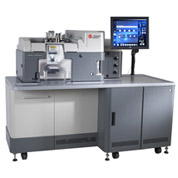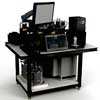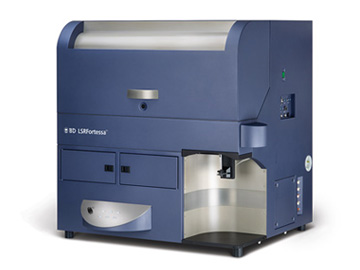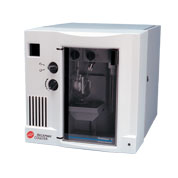|
RESOURCES AND INSTRUMENTATION >
INSTRUMENTATION

Flow Cytometry
The Bauer Core provides cell sorters, analyzers and particle counters on which we offer
a combination of training and service. For more information about
running anexperiment and the services offered,
please see Flow Cytometry Techniques & Protocols.
 |
Beckman Coulter MoFlo Astrios EQ Cell Sorter
The MoFlo Astrios EQ is a high speed cell sorter with 7 lasers, 34 detectors, and 6 way sorting capability. It is equipped with a 355nm, 405nm, 488nm, 532nm, 561nm, 592nm, and 640nm lasers. The instrument is also equipped with a dual forward scatter PMT small particle detector that allows for the measurement of submicron particles. Common nozzle sizes used on the instrument are the 70 micron and the 100 micron. The sorter is inside a Baker bio safety cabinet for sorting bio safety level two samples. A variety of collection devices can be used including: microscope slides, micro tubes, 12x75 test tubes, 15ml or 50ml falcon tubes, as well as multi well plates (6, 24, 96, 384, 1536, or custom). The collection device as well as the sample chamber can be cooled or warmed during sorting. The Astrios is capable of sorting into plates with the sort stream straight down instead of at an angle like most traditional sorters. Index sorting is also available for single cell plate sorting. This instrument is operated by staff on a fee for service basis.
For more information about the XDP, see http://www.coulterflow.com/bciflow/homena.php.
To learn about using this instrument, please contact Patricia Rogers (progers@cgr.harvard.edu, 617-496-8453). |
 |
Beckman Coulter MoFlo XDP Cell Sorter
The XDP is a high speed cell sorter with 4 lasers, 9 colors, and 4 way sorting capability. It is equipped with a 488nm, 405nm, 561nm, and 635nm lasers. The XDP uses complete digital processing and can sort a high yield of cells at a greater efficiency. A variety of collection devices may be used including: microscope slides, micro-tubes, 12 x 75ml test tubes, 15 or 50ml falcon tubes, as well as multi-well plates (6, 24, 96, 384, or 1536). The sort collection device may be cooled or warmed while sorting. The sorter is inside of a biosafety cabinet for sorting bio safety level 2 samples. This instrument is operated by staff on a fee for service basis.
For more information about the XDP, see http://www.coulterflow.com/bciflow/homena.php .
To learn about using this instrument, please contact Patricia Rogers (progers@cgr.harvard.edu, 617-496-8453). |
 |
Beckman Coulter MoFlo Legacy Cell Sorter
The MoFlo is a high speed cell sorter with three lasers, 9 colors, and two way sorting capability. It is equipped with a solid state 488nm laser, an I90 argon ion multiline UV laser, and an I70C spectrum tunable laser (providing wavelengths from 440nm to 568nm). A variety of collection devices may be used including: microscope slides, micro-tubes, 12 x 75ml test tubes, 15 or 50ml falcon tubes, as well as multi-well plates (6, 24, 96, or 384). This instrument is operated by staff on a fee for service basis.
For more information about the MoFlo, see http://www.coulterflow.com/bciflow/homena.php
To learn about using this instrument, please contact Patricia Rogers (progers@cgr.harvard.edu, 617-496-8453). |
 |
BD FACS AriaIIIu Cell Sorter
The FACS Aria IIIu cell sorter is equipped with five lasers (405nm, 440nm, 488nm, 561nm, and 635nm), 18 detectors, and 4 way sorting capability. The instrument is currently operating with FACS Diva version 7 and can use index sorting. Common nozzle sizes used on the instrument include the 70 micron, 85 micron, 100 micron, and 130 micron. The Aria can sort into a variety of collection devices including: microscope slides, micro-tubes, 12 x 75ml test tubes, 15ml falcon tubes, as well as multi-well plates (6, 24, 96, or 384). The collection device can be cooled or warmed during the sort. The fixed nozzle eliminates the need for laser alignment with every run and makes this instrument easier to use than the MoFlo. For this reason, people who anticipate heavy use of the instrument and who have already taken the LSRII/Fortessa training can be trained to use it independently. Users who need it less frequently can have their samples run by the facility.
For more information see http://www.bdbiosciences.com/home/.
To learn about using this instrument, please contact Patricia Rogers (progers@cgr.harvard.edu, 617-496-8453). |
 |
Union Biometrica BioSorter
The BioSorter is a large particle sorter designed to sort objects that are typically too large for traditional droplet cell sorters. The instrument is configurable with different sized flow cells that range from 250 microns up to 2000 microns. The core facility currently has the 250 micron flow cell and can handle adult C Elegans easily or other similar sized objects. The BioSorter is configured with three excitation lasers: 405nm, 488nm, and 561nm and has three detectors for fluorescence as well as extinction and time of flight measurements. Samples are introduced via a 50 ml falcon tube and mixed with a suspended stirrer. The associated LP sampler is for taking samples from 96/384 well plates, and the instrument can sort into a variety of collection devices including tubes and 96/384 well plates.
For more information see http://www.unionbio.com/biosorter/.
To learn about using this instrument, please contact Patricia Rogers (progers@cgr.harvard.edu, 617-496-8453). |
 |
BD LSRII
This analyzer has 4 lasers (405, 488, 561, and 633 nm) and can be used
to analyze cells stained with many different fluorophores (fluorescent
proteins, DsRed, mCherry, APC, and phycoerythrin, among others). Like the FACSARIA,
the LSRII has a PMT option to allow a greater dynamic range for FSC.
The high throughput sampler (HTS) allows cells to be taken from a
96 or 384 well plate. Researchers can be trained to use this instrument
independently. For more information see http://www.bdbiosciences.com.
To learn about using this instrument, please contact Patricia Rogers (progers@cgr.harvard.edu, 617-496-8453). |
 |
BD LSR Fortessa
This analyzer has 4 lasers (440, 488, 561, and 633 nm) and can be used to analyze cells stained with many different fluorophores (fluorescent proteins, DsRed, mCherry, APC, and phycoerythrin, among others). The high throughput sampler (HTS) allows cells to be taken from a 96 or 384 well plate. Researchers can be trained to use this instrument independently. For more information see http://www.bdbiosciences.com.
To learn about using this instrument, please contact Patricia Rogers (progers@cgr.harvard.edu, 617-496-8453). |
Ancillary Equipment for Flow Cytometry Projects
The core offers instruments sample preparation, cell counting and viability staining.
|
 |
Beckman Coulter Multisizer
The Multisizer™ 3 Coulter Counter is a particle sizing and counting analyzer. The coulter counter uses an Electrical Sensing Zone Method to generate data on number, volume, mass, and surface area size distributions of particles. Apertures of 50 µM and 100 µM are currently available to measure particles ranging from 1-60 µM in diameter. Researchers can be trained to use this instrument independently. For more information see https://www.beckmancoulter.com/.
To learn about using this instrument, please contact Patricia Rogers (progers@cgr.harvard.edu, 617-496-8453). |
 |
Countess Automated Cell Counter
The Countess is a bench top automated hemocytometer designed for accurately measuring cell counts and viability using trypan blue. The instrument uses disposable plastic slides that can analyze up to two samples and requires 10µl of sample volume plus 10µl of trypan blue. The Countess is best suited for eukaryotic cells. Researchers can be trained to use this instrument independently. For more information about the Countess, see http://www.lifetechnologies.com/us/en/home/brands/product-brand/countess-automated-cell-counter.html.
To learn about using this instrument, please contact Patricia Rogers (progers@cgr.harvard.edu, 617-496-8453). |
|










